Privateer
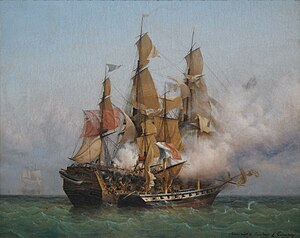
A privateer is a private person or vessel which engages in maritime warfare under a commission of war.[1] Since robbery under arms was a common aspect of seaborne trade, until the early 19th century all merchant ships carried arms. A sovereign or delegated authority issued commissions, also referred to as letters of marque, during wartime. The commission empowered the holder to carry on all forms of hostility permissible at sea by the usages of war. This included attacking foreign vessels and taking them as prizes and taking crews prisoner for exchange. Captured ships were subject to condemnation and sale under prize law, with the proceeds divided by percentage between the privateer's sponsors, shipowners, captains and crew. A percentage share usually went to the issuer of the commission (i.e. the sovereign).
Privateering allowed sovereigns to raise revenue for war by mobilizing privately owned armed ships and sailors to supplement state power. For participants, privateering provided the potential for a greater income and profit than obtainable as a merchant seafarer or fisher. However, this incentive increased the risk of privateers turning to piracy when war ended.
The commission usually protected privateers from accusations of piracy, but in practice the historical legality and status of privateers could be vague. Depending on the specific sovereign and the time period, commissions might be issued hastily; privateers might take actions beyond what was authorized in the commission, including after its expiry. A privateer who continued raiding after the expiration of a commission or the signing of a peace treaty could face accusations of piracy. The risk of piracy and the emergence of the modern state system of centralised military control caused the decline of privateering by the end of the 19th century.
Legal framework and relation to piracy
The commission was the proof the privateer was not a
In British law, under the
The legal framework around authorised sea-raiding was considerably murkier outside of Europe. Unfamiliarity with local forms of authority created difficulty determining who was legitimately sovereign on land and at sea, whether to accept their authority, or whether the opposing parties were, in fact, pirates. Mediterranean
Privateers were implicated in piracy for a number of complex reasons. For colonial authorities, successful privateers were skilled seafarers who brought in much-needed revenue, especially in newly settled colonial outposts.
Some privateers faced prosecution for piracy. William Kidd accepted a commission from King William III of England to hunt pirates but was later hanged for piracy. He had been unable to produce the papers of the prizes he had captured to prove his innocence.[8]
Privateering commissions were easy to obtain during wartime but when the war ended and sovereigns recalled the privateers, many refused to give up the lucrative business and turned to piracy.[9] Boston minister Cotton Mather lamented after the execution of pirate John Quelch: "Yea, since the privateering stroke so easily degenerates into the piratical and the privateering trade is usually carried on with so un-Christian a temper and proves an inlet unto so much debauchery and iniquity and confusion, I believe I shall have good men concur with me in wishing that privateering may no more be practised except there may appear more hopeful circumstances to encourage it."[10]
Noted privateers
Privateers who were considered legitimate by their governments include:
- Miguel Enríquez (Puerto Rico)
- Dutch Empire)
- Amaro Pargo (Spanish Empire or Hispanic Monarchy)
- Hayreddin Barbarossa (Ottoman Empire)
- Robert Surcouf (France)
- Lars Gathenhielm (Sweden)
- Sir Francis Drake (England)
- Sir John Hawkins (England)
- Juana Larando (Basque Country)
Ships
Entrepreneurs converted many different types of vessels into privateers, including obsolete warships and refitted merchant ships. The investors would arm the vessels and recruit large crews, much larger than a merchantman or a naval vessel would carry, in order to crew the prizes they captured. Privateers generally cruised independently, but it was not unknown for them to form squadrons, or to co-operate with the regular navy. A number of privateers were part of the English fleet that opposed the Spanish Armada in 1588. Privateers generally avoided encounters with warships, as such encounters would be at best unprofitable. Still, such encounters did occur. For instance, in 1815 Chasseur encountered HMS St Lawrence, herself a former American privateer, mistaking her for a merchantman until too late; in this instance, however, the privateer prevailed.
The United States used mixed squadrons of frigates and privateers in the American Revolutionary War. Following the French Revolution, French privateers became a menace to British and American shipping in the western Atlantic and the Caribbean, resulting in the Quasi-War, a brief conflict between France and the United States, fought largely at sea, and to the Royal Navy's procuring Bermuda sloops to combat the French privateers.[11]
Overall history
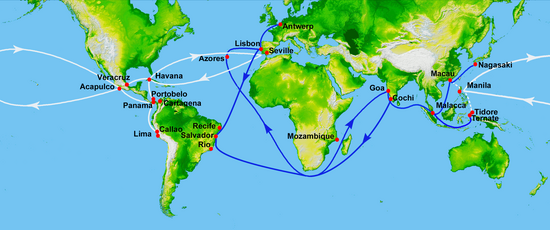
In Europe, the practice of authorising sea-raiding dated to at least the 13th century but the word 'privateer' was coined sometime in the mid-17th century.
Privateers were a large part of the total military force at sea during the 17th and 18th centuries. In the
As the
England/Britain
In England, and later the United Kingdom, the ubiquity of wars and the island nation's reliance on maritime trade enabled the use of privateers to great effect. England also suffered much from other nations' privateering. During the 15th century, the country "lacked an institutional structure and coordinated finance".[13] When piracy became an increasing problem, merchant communities such as Bristol began to resort to self-help, arming and equipping ships at their own expense to protect commerce.[15] The licensing of these privately owned merchant ships by the Crown enabled them to legitimately capture vessels that were deemed pirates. This constituted a "revolution in naval strategy" and helped fill the need for protection that the Crown was unable to provide.
During the reign of
Elizabeth was succeeded by the first Stuart monarchs,

England and Scotland practiced privateering both separately and together after they united to create the Kingdom of Great Britain in 1707. It was a way to gain for themselves some of the wealth the Spanish and Portuguese were taking from the New World before beginning their own trans-Atlantic settlement, and a way to assert naval power before a strong Royal Navy emerged.
Sir
Sir Francis Drake, who had close contact with the sovereign, was responsible for some damage to Spanish shipping, as well as attacks on Spanish settlements in the Americas in the 16th century. He participated in the successful English defence against the Spanish Armada in 1588, though he was also partly responsible for the failure of the English Armada against Spain in 1589.
Sir
Captain Christopher Newport led more attacks on Spanish shipping and settlements than any other English privateer. As a young man, Newport sailed with Sir Francis Drake in the attack on the Spanish fleet at Cadiz and participated in England's defeat of the Spanish Armada. During the war with Spain, Newport seized fortunes of Spanish and Portuguese treasure in fierce sea battles in the West Indies as a privateer for Queen Elizabeth I. He lost an arm whilst capturing a Spanish ship during an expedition in 1590, but despite this, he continued on privateering, successfully blockading Western Cuba the following year. In 1592, Newport captured the Portuguese carrack Madre de Deus (Mother of God), valued at £500,000.
Sir Henry Morgan was a successful privateer. Operating out of Jamaica, he carried on a war against Spanish interests in the region, often using cunning tactics. His operation was prone to cruelty against those he captured, including torture to gain information about booty, and in one case using priests as human shields. Despite reproaches for some of his excesses, he was generally protected by Sir Thomas Modyford, the governor of Jamaica. He took an enormous amount of booty, as well as landing his privateers ashore and attacking land fortifications, including the sack of the city of Panama with only 1,400 crew.[22]
Other British privateers of note include
Bermudians
The English colony of
The Bahamas, which had been depopulated of its indigenous inhabitants by the Spanish, had been settled by England, beginning with the
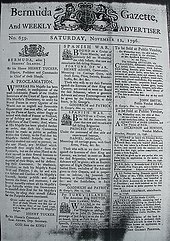
Bermuda was in de facto control of the
Despite strong sentiments in support of the rebels, especially in the early stages, Bermudian privateers turned as aggressively on American shipping during the
An American naval captain, ordered to take his ship out of Boston Harbor to eliminate a pair of Bermudian privateering vessels that had been picking off vessels missed by the Royal Navy, returned frustrated, saying, "the Bermudians sailed their ships two feet for every one of ours".[29] Around 10,000 Bermudians emigrated in the years prior to American independence, mostly to the American colonies. Many Bermudians occupied prominent positions in American seaports, from where they continued their maritime trades (Bermudian merchants controlled much of the trade through ports like Charleston, South Carolina, and Bermudian shipbuilders influenced the development of American vessels, like the Chesapeake Bay schooner),[25][30][31] and in the Revolution they used their knowledge of Bermudians and of Bermuda, as well as their vessels, for the rebels' cause. In the 1777 Battle of Wreck Hill, brothers Charles and Francis Morgan, members of a large Bermudian enclave that had dominated Charleston, South Carolina and its environs since settlement,[32][33] captaining two sloops (the Fair American and the Experiment, respectively), carried out the only attack on Bermuda during the war. The target was a fort that guarded a little used passage through the encompassing reef line. After the soldiers manning the fort were forced to abandon it, they spiked its guns and fled themselves before reinforcements could arrive.[34]

When the Americans captured the Bermudian privateer Regulator, they discovered that virtually all of her crew were black slaves. Authorities in Boston offered these men their freedom, but all 70 elected to be treated as
The War of 1812 saw an encore of Bermudian privateering, which had died out after the 1790s. The decline of Bermudian privateering was due partly to the buildup of the naval base in Bermuda, which reduced the Admiralty's reliance on privateers in the western Atlantic, and partly to successful American legal suits and claims for damages pressed against British privateers, a large portion of which were aimed squarely at the Bermudians.[32] During the course of the War of 1812, Bermudian privateers captured 298 ships, some 19% of the 1,593 vessels captured by British naval and privateering vessels between the Great Lakes and the West Indies.[37]
Among the better known (native-born and immigrant) Bermudian privateers were Hezekiah Frith, Bridger Goodrich,[38] Henry Jennings, Thomas Hewetson,[39] and Thomas Tew.
Providence Island colony
Bermudians were also involved in privateering from the short-lived English colony on Isla de Providencia, off the coast of Nicaragua. This colony was initially settled largely via Bermuda, with about eighty Bermudians moved to Providence in 1631. Although it was intended that the colony be used to grow cash crops, its location in the heart of the Spanish controlled territory ensured that it quickly became a base for privateering.
Bermuda-based privateer
The Spanish did not hear of the Providence Island colony until 1635 when they captured some Englishmen in
In March 1636 the Company dispatched Captain
On 11 July 1640, the Spanish Ambassador in London complained again, saying he
understands that there is lately brought in at the Isle of Wight by one, Captain James Reskinner [James Reiskimmer], a ship very richly laden with silver, gold, diamonds, pearls, jewels, and many other precious commodities taken by him in virtue of a commission of the said Earl [of Warwick] from the subjects of his Catholic Majesty ... to the infinite wrong and dishonour of his Catholic Majesty, to find himself thus injured and violated, and his subjects thus spoiled, robbed, impoverished and murdered in the highest time of peace, league and amity with your Majesty.[44]
Nathaniel Butler, formerly Governor of Bermuda, was the last full governor of Providence Island, replacing Robert Hunt in 1638. Butler returned to England in 1640, satisfied that the fortifications were adequate, deputizing the governorship to Captain Andrew Carter.[45]
In 1640, don Melchor de Aguilera, Governor and Captain-General of Cartagena, resolved to remove the intolerable infestation of pirates on the island. Taking advantage of having infantry from Castile and Portugal wintering in his port, he dispatched six hundred armed Spaniards from the fleet and the presidio, and two hundred black and mulatto militiamen under the leadership of don Antonio Maldonado y Tejada, his Sergeant Major, in six small frigates and a galleon.[46] The troops were landed on the island, and a fierce fight ensued. The Spanish were forced to withdraw when a gale blew up and threatened their ships. Carter had the Spanish prisoners executed. When the Puritan leaders protested against this brutality, Carter sent four of them home in chains.[47]
The Spanish acted decisively to avenge their defeat. General Francisco Díaz Pimienta was given orders by King Philip IV of Spain, and sailed from Cartagena to Providence with seven large ships, four pinnaces, 1,400 soldiers and 600 seamen, arriving on 19 May 1641. At first, Pimienta planned to attack the poorly defended east side, and the English rushed there to improvise defenses. With the winds against him, Pimienta changed plans and made for the main New Westminster harbor and launched his attack on 24 May. He held back his large ships to avoid damage, and used the pinnaces to attack the forts. The Spanish troops quickly gained control, and once the forts saw the Spanish flag flying over the governor's house, they began negotiations for surrender.[48]
On 25 May 1641, Pimienta formally took possession and celebrated mass in the church. The Spanish took sixty guns, and captured the 350 settlers who remained on the island – others had escaped to the Mosquito Coast. They took the prisoners to Cartagena.[49] The women and children were given a passage back to England. The Spanish found gold, indigo, cochineal and six hundred black slaves on the island, worth a total of 500,000 ducats, some of the accumulated booty from the raids on Spanish ships.[50] Rather than destroy the defenses, as instructed, Pimienta left a small garrison of 150 men to hold the island and prevent occupation by the Dutch.[49] Later that year, Captain John Humphrey, who had been chosen to succeed Captain Butler as governor, arrived with a large group of dissatisfied settlers from New England. He found the Spanish occupying the islands, and sailed away.[51] Pimienta's decision to occupy the island was approved in 1643 and he was made a knight of the Order of Santiago.[49]
Spain and its colonies
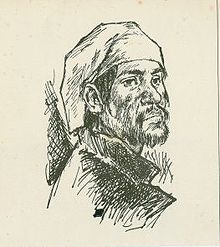
When Spain issued a decree blocking foreign countries from trading, selling or buying merchandise in its Caribbean colonies, the entire region became engulfed in a power struggle among the naval superpowers.
France
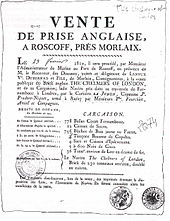
Corsairs (French: corsaire) were privateers, authorized to conduct raids on shipping of a nation at war with France, on behalf of the French Crown. Seized vessels and cargo were sold at auction, with the corsair captain entitled to a portion of the proceeds. Although not
Malta
Corsairing (
United States
British Colonial period
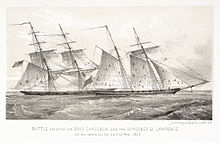
During
In the subsequent conflict, the
American Revolutionary War
During the
About 55,000 American seamen served aboard the privateers.[58] They quickly sold their prizes, dividing their profits with the financier (persons or company) and the state (colony). Long Island Sound became a hornets' nest of privateering activity during the American Revolution (1775–1783), as most transports to and from New York went through the Sound. New London, Connecticut was a chief privateering port for the American colonies, leading to the British Navy blockading it in 1778–1779. Chief financiers of privateering included Thomas & Nathaniel Shaw of New London and John McCurdy of Lyme. In the months before the British raid on New London and Groton, a New London privateer took Hannah in what is regarded as the largest prize taken by any American privateer during the war. Retribution was likely part of Gov. Clinton's (NY) motivation for Arnold's Raid, as the Hannah had carried many of his most cherished items.
American privateers are thought to have seized up to 300 British ships during the war. The British ship Jack was
The
War of 1812
During the War of 1812, both the British and the American governments used privateers, and the established system was very similar.[61] U.S. Congress declared
that war be and the same is hereby declared to exist between the United Kingdom of Great Britain and Ireland and the dependencies thereof, and the United States of America and their Territories; and that the President of the United States is herby authorized to use the whole land and naval force of the United States to carry the same into effect, and to issue to private armed vessels of the United States commissions of marque and general reprisal, in such forms as he shall think proper, and under the seal of the United States, against the vessels, goods, and effects of the Government of the said United Kingdom of Great Britain and Ireland, and the subjects thereof.[62]
President Madison issued 500 letters of marque authorizing privateers. Overall some 200 of the ships took prizes. The cost of buying and fitting of a large privateer was about $40,000 and prizes could net $100,000.[63]
Captain
On April 8, 1814, the British
Jean Lafitte and his privateers aided US General Andrew Jackson in the defeat of the British in the Battle of New Orleans in order to receive full pardons for their previous crimes.[66][67][68][69][70] Jackson formally requested clemency for Lafitte and the men who had served under him, and the US government granted them all a full pardon on February 6, 1815.[71][72]
However, many of the ships captured by the Americans were recaptured by the Royal Navy. British convoy systems honed during the Napoleonic Wars limited losses to singleton ships, and the effective blockade of American and continental ports prevented captured ships being taken in for sale. This ultimately led to orders forbidding US privateers from attempting to bring their prizes in to port, with captured ships instead having to be burnt. Over 200 American privateer ships were captured by the Royal Navy, many of which were turned on their former owners and used by the British blockading forces. Nonetheless, during the War of 1812 the privateers "swept out from America's coasts, capturing and sinking as many as 2,500 British ships and doing approximately $40 million worth of damage to the British economy."[61]
1856 Declaration of Paris
The US was not one of the initial signatories of the 1856
American Civil War
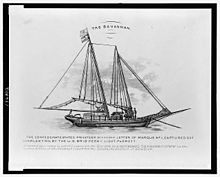
During the
During the Civil War Confederate President Jefferson Davis issued letters of marque to anyone who would employ their ship to either attack Union shipping or bring badly needed supplies through the Union blockade into southern ports.[73]
Most of the supplies brought into the Confederacy were carried aboard privately owned vessels. When word came about that the Confederacy was willing to pay almost any price for military supplies, various interested parties designed and built specially designed lightweight seagoing steamers, blockade runners specifically designed and built to outrun Union ships on blockade patrol.[74]
Neither the United States nor Spain authorized privateers in their war in 1898.[75]
Latin America
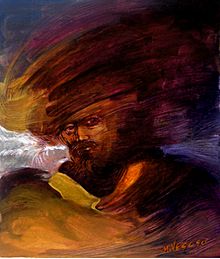
Warships were recruited by the insurgent governments during Spanish American wars of independence to destroy Spanish trade, and capture Spanish Merchant vessels. The private armed vessels came largely from the United States. Seamen from Britain, the United States, and France often manned these ships.
Computer hackers
Modern-day
See also
- Armed merchantman
- Louis-Michel Aury
- Auxiliary cruiser
- "Barrett's Privateers"
- Samuel Bellamy
- Buccaneer
- Renato Beluche
- Paul Beneke
- Commerce raiding
- Filibuster (military)
- Foreign Enlistment Act 1870 (UK)
- Violent non-state actors at sea
- Mercenary
- Merchant raider
- Neutrality Act of 1794 (US)
- Pindari
- Private military company
- Reprisal
- State-sponsored terrorism
- William Walker (filibuster)
- Dominique You
References
- ISBN 9780691086583.
- ^ S2CID 159998526.
- ^ Warren, James Francis (1981). The Sulu Zone 1768–1898. Singapore: Singapore University Press.
- ^ Murray, Dian H. (1987). Pirates of the South China Coast. California: Stanford University Press.
- ^ Zahedieh, Nuala (2005). "A Frugal Prudential and Hopeful Trade': Privateering in Jamaica, 1644–89". In Glete, Jan (ed.). Naval History 1500–1680. The International Library of Essays on Military History. Hants, England: Ashgate Publishing Limited. pp. 145–168.
- ISBN 9781598842012. Retrieved 12 September 2017.
- ISBN 9781611685275. Retrieved 31 January 2019.
- ^ Ritchie, Robert C. (1986). Captain Kidd and the War against the Pirates. Cambridge, Massachusetts: Harvard University Press.
- ^ Arnold, Samuel Greene (1859). History of the State of Rhode Island, Volume I: 1636–1700. New York: Appleton. pp. 540–541. Retrieved 31 January 2019.
- ^ Mather, Cotton (October 2007). Faithful warnings to prevent fearful judgments. Uttered in a brief discourse, occasioned, by a tragical spectacle, in a number of miserables under a sentence of death for piracy. At Boston in N.E. Jun. 22. 1704.: [Five lines of quotations]. Retrieved 31 January 2019.
- ^ Bermuda Gazette and Weekly Advertiser August 15, 1795
- S2CID 146428782.
- ^ a b Loades, D. M. (2009). The Making of the Elizabethan Navy, 1540–1590: From the Solent to the Armada. Woodbridge: Boydell. pp. 1, 53.
- ^ a b bean (6 March 2022). "Letters of Marque Today". Naval Gazing. Retrieved 29 June 2022.
- ^ Loades, D. M. (2009). The Making of the Elizabethan Navy, 1540–1590: From the Solent to the Armada. Woodbridge: Boydell. p. 3.
- ^ Loades, D. M. (2009). The Making of the Elizabethan Navy, 1540–1590: From the Solent to the Armada. Woodbridge: Boydell. p. 121.
- ^ Loades, D. M. (2009). The Making of the Elizabethan Navy, 1540–1590: From the Solent to the Armada. Woodbridge: Boydell. p. 113.
- ^ Andrews, Kenneth R. (1984). Trade, Plunder and Settlement 1480-1630. Cambridge: Cambridge University Press.
- ^ Andrews, Kenneth R. (1984). Trade, Plunder and Settlement 1480-1630. Cambridge: Cambridge University Pr3ess.
- ^ Senior, Clive M. (1976). A Nation of Pirates: English Piracy in its Heyday. Newton Abbot, UK: David & Charles.
- ^ McCarthy, Matthew (2013). Privateering, Piracy and British Policy in Spanish America 1810–1830. Woodbridge, UK: Boydell Press.[page needed]
- ^ "The Legendary Captain Morgan Raids Panama!". ThoughtCo. Retrieved 2017-10-19.
- ^ "Cedar on the Reef", ScholarShip. East Carolina University (PDF)
- ^ Southerly, James Christopher Welliver. "Cedar on the reef: archaeological and historical assessments of the Eighteenth-Century Bermuda Sloop, exemplified by the wreck of the Hunter Galley". libres.uncg.edu. Retrieved 6 February 2019.
- ^ a b Jarvis, Michael (2010). In the Eye of All Trade: Bermuda, Bermudians, and the Maritime Atlantic World, 1680–1783. Chapel Hill: University of North Carolina Press.[page needed]
- ASIN B0007J8WMW
- ^ Cooke, Bill (2002). "Foreign Interlopers at Bermuda's Turks Islands". Maritimes: The Magazine of the Bermuda Maritime Museum. Vol. 15, no. 2.
- ^ Shorto, Lieutenant-Colonel A. Gavin (2018-04-05). "Bermuda in the Privateering Business". The Bermudian. City of Hamilton, Pembroke Parish, Bermuda: The Bermudian. Retrieved 2023-11-26.
- ^ Williams, Ronald John (1946). Bermudiana. Rinehart & Company, Inc.[page needed]
- ISBN 978-0870335112
- ^ Jarvis, Michael (June 2001). "The Exodus". The Bermudian magazine.
- ^ a b Wilkinson, Henry. Bermuda From Sail To Steam: The History Of The Island From 1784 to 1901. Oxford: Oxford University Press.
- ISBN 0-921560-11-7– via The Bermuda Maritime Museum.
- ^ "1777: The US Navy & The Battle Of Wreck Hill". 8 April 2012. Retrieved 6 February 2019.
- ^ Jarvis, Michael J. "Maritime Masters and Seafaring Slaves in Bermuda, 1680–1783" (PDF). Archived from the original (PDF) on 30 January 2012. Retrieved 6 February 2019 – via The Jefferson Library.
- ^ John Lenis (1783-04-04). "A list of 130 prizes (ships) captured and brought into the port of Bermuda between 4..." National Archives of the British Government. CO 37/39/14. Retrieved 2021-10-03.
- Bermuda Maritime Museum..
- ISBN 978-0947712518.
- ^ Shorto, Gavin. "Bermuda in the Privateering Business". The Bermudian. Archived from the original on 2011-07-16. Retrieved 2011-01-21.
- ^ Offen 2011.
- ^ Latimer 2009, pp. 85–86.
- ^ Latimer 2009, p. 86.
- ^ Latimer 2009, p. 83.
- ^ Latimer 2009, pp. 89–90.
- ^ Kupperman 1993, pp. 242–243.
- ^ Conquista de la Isla de Santa Catalina.
- ^ Hamshere 1972, pp. 48–49.
- ^ Latimer 2009, p. 90.
- ^ a b c Latimer 2009, pp. 90–91.
- ^ Hamshere 1972, p. 49.
- ^ Kupperman 1993, p. 250.
- ^ a b c Carmen Dolores Trelles (1991-01-09). "En busca de Cofresí". El Nuevo Día (in Spanish). Archived from the original on 2013-12-05. Retrieved 2013-11-12.
- ^ Bracho Palma, Jairo (2005). La defensa marítima en la Capitanía General de Venezuela, 1783–1813. Instituto Nacional de los Espacios Acuáticos e Insulares. p. 87.
- ^ Cassar, Paul (January–March 1963). "The Maltese Corsairs and the Order of St. John of Jerusalem" (PDF). Scientia. 29 (1): 26–41. Archived from the original (PDF) on 3 February 2016.
- The Times. Archived from the originalon 3 February 2016.
- ^ a b c Privateering and the Private Production of Naval Power, Gary M. Anderson and Adam Gifford Jr.
- ^ Brewer, John. The Sinews of Power: War, Money, and the English State, 1688–1783. New York.: Alfred A. Knopf, 1989. p. 197
- ^ "Privateers or Merchant Mariners help win the Revolutionary War". www.usmm.org. Retrieved 6 February 2019.
- ^ "US Navy Fleet List War of 1812". Archived from the original on January 9, 2009.
- ^ Oren, Michael B. (2005-11-03). "The Middle East and the Making of the United States, 1776 to 1815". Retrieved 2007-02-18.
- ^ ISSN 1086-1653.
- ^ "Annals of Congress Home Page: U.S. Congressional Documents". American Memory - Library of Congress.
- ^ "12 at Midnight; the Hibernia attempting to run the Comet down". npg.si.edu. Archived from the original on 2019-04-27. Retrieved 2019-04-27.
- OCLC 1084236819.
- OCLC 16870651.
- ^ Ramsay (1996), p. 62.
- ^ Ramsay (1996), p. 69.
- ^ Ramsay (1996), p. 70.
- ^ Ramsay (1996), p. 71.
- ^ Ramsay (1996), p. 77.
- ^ Ramsay (1996), p. 82.
- ^ Ingersoll (1852) pp. 82–83
- JSTOR 3633146.
- ^ Hamilton Cochran, Blockade Runners of the Confederacy (U of Alabama Press, 2005).
- ^ Scott D. Wagner, "Why there was no privateering in the Spanish-American War." International Journal of Naval History 14.1 (2018).
- ^ Egloff, Florian. Cybersecurity and the Age of Privateering. In: Understanding Cyber Conflict: Fourteen Analogies, Chapter 14, George Perkovich and Ariel E. Levite, Eds., Georgetown University Press, 2017.
- ^ Tidy, Joe. Ransomware: Should paying hacker ransoms be illegal? BBC 20 May 2021.
- ^ Morrison, Sara. What you need to know about ransomware and the future of cyberattacks. Vox, Jun 16, 2021.
- ^ Abigail Summerville, Protect against the Fastest-Growing Crime: Cyber Attacks, CNBC (July 25, 2017).
- ^ Myre, Greg. How Bitcoin Has Fueled Ransomware Attacks. NPR, June 10, 2021.
Bibliography
- "Conquista de la Isla de Santa Catalina". Varias relaciones del Perú y Chile: y conquista de la isla de Santa Catalina, 1535 á 1658. Impr. de M. Ginesta. 1879. p. 331. Retrieved 12 September 2012.
- Cochran, Hamilton (2005). Blockade Runners of the Confederacy. University of Alabama Press.
- Dyer, Brainerd (1934). "Confederate Naval and Privateering Activities in the Pacific". Pacific Historical Review. 3 (4): 433–443. JSTOR 3633146.
- Hamshere, Cyril (1972). "Providence". The British in the Caribbean. Harvard University Press. p. 46. Retrieved 2012-09-10.
- Ingersoll, Charles Jared (1852). History of the second war between the United States of America and Great Britain: declared by act of Congress, the 18th of June, 1812, and concluded by peace, the 15th of February, 1815. Lippincott, Grambo & Co.
- ISBN 978-0-87413-411-7. Retrieved 2012-09-09.
- Latimer, Jon (2009). Buccaneers of the Caribbean: How Piracy Forged an Empire. Harvard University Press. p. 84. ISBN 978-0-674-03403-7. Retrieved 2012-09-07.
- Offen, Karl (March 2011). "La cartografía colonial de Centroamérica y el topónimo 'mosquito'". Asociación para el Fomento de los Estudios Históricos en Centroamérica. Archived from the original on 2018-06-19. Retrieved 2012-09-06.
- Ramsay, Jack C. (1996). Jean Laffite: Prince of Pirates. Eakin Press. ISBN 978-1-57168-029-7.
- Wagner, Scott D. (2018). "Why there was no privateering in the Spanish-American War". International Journal of Naval History. 14 (1).
Further reading
- Alberto, Edite Maria Conceição Martins. (2019) "A Pious Business: the ransoming of captives in Early Modern Portugal." E-Journal of Portuguese History 17.2 (2019).
- Beattie, Tim. (2015). British Privateering Voyages of the Early Eighteenth Century (Boydell. 2015).
- Colás, A. (2016). "Barbary Coast in the expansion of international society: Piracy, privateering, and corsairing as primary institutions." Review of International Studies, 42#5: 840–857.
- Espersen, Ryan. (2019) "Fifty Shades of Trade: Privateering, Piracy, and Illegal Slave Trading in St. Thomas, Early Nineteenth Century." New West Indian Guide/Nieuwe West-Indische Gids 93.1–2 (2019): 41–68. online
- Faye, Kert (1997) Prize and Prejudice Privateering and Naval Prize in Atlantic Canada in the War of 1812. (Research in maritime history, no. 11. St. John's, Nfld: International Maritime Economic History Association).
- Haggerty, Sheryllynne. (2018) "Risk, networks and privateering in Liverpool during the Seven Years' War, 1756–1763." International Journal of Maritime History 30.1 (2018): 30–51 online
- Head, David (2015) Privateers of the Americas: Spanish American Privateering from the United States in the Early Republic. (Athens, GA: University of Georgia Press). 2015.
- Kert, Faye Margaret. (2017) Prize and Prejudice: Privateering and Naval Prize in Atlantic Canada in the War of 1812 (Oxford University Press, 2017).
- Krasner, Barbara. (2016) Sir Francis Drake: Privateering Sea Captain and Circumnavigator of the Globe (Rosen, 2016).
- Lemnitzer, Jan (2014) Power, Law and the End of Privateering.
- Nichols, A. Bryant Jr. (2007) Captain Christopher Newport: Admiral of Virginia. (Sea Venture).
- Rommelse, Gijs. "Privateering as a language of international politics: English and French privateering against the Dutch Republic, 1655–1665." Journal for Maritime Research 17.2 (2015): 183–194.
- Ross, Nicholas (2011) "The Provision of Naval Defense in the Early American Republic: A Comparison of the U.S. Navy and Privateers, 1789–1815." The Independent Review 16, no. 3 (Winter).
- Smith, Joshua M. (2011) Battle for the Bay: The Naval War of 1812. (Fredericton, NB: Goose Lane Editions).
- van Nieuwenhuize, Hielke. (2017) "Prize law, international diplomacy and the treatment of foreign prizes in the seventeenth century: a case study." Comparative legal history 5.1 (2017): 142–161.
- Wold, Atle L. (2020) "After the Closure of the Ports in 1799." in Privateering and Diplomacy, 1793–1807. (Palgrave Macmillan, Cham, 2020) pp. 213–228.
Primary sources
- Andrews, K.R. ed. (2017). English Privateering Voyages to the West Indies, 1588–1595: Documents relating to English voyages to the West Indies, from the defeat of the Armada to the last voyage of Sir Francis Drake, including Spanish documents contributed by Irene A. Wright (Taylor & Francis).
- Privateering and Piracy in the Colonial Period: Illustrative Documents at Project Gutenberg ed. by Jameson, John Franklin.
External links
- Andrew Sherburne's Experiences on a Privateer During the Revolutionary War
- Commerce Raiding: Historical Case Studies, 1755–2009 Naval War College
- The Gentleman's Magazine, and Historical Chronicle, Volume 49 1779 account of capture of "Weymouth" Packet by privateer General Sullivan; the "Weymouth" was later recaptured by The Rawlinson and the Clarendon, of Liverpool recaptured off the Land's End; see Willams, Gomer "History of the Liverpool Privateers and Letters of Marque: With an Account …

